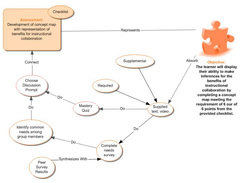Why Collaborate?Why Collaborate is a lesson activity to move the class participants into a reflective state. The student will harness the power of concept mapping and graphic organizers to make connections between prior knowledge, contextual evidence and important vocabulary to make inferences for the benefits of instructional collaboration.
Concept maps use David Ausubel’s assimilation theory to identify relationships between prior knowledge and content to make connections to new concepts. (Young & Whitehead, 2008). They graphically synthesize information together to create a broader picture.  Select image for magnified viewing. Select image for magnified viewing.
Class participants will review research, videos, and documents to extend their awareness of types of collaboration and barriers that may exist.
Students will participate within a educational needs survey and collaborate together to identify common needs within the group. An individual check for understanding mastery quiz will be used as a formative assessment to encourage reflection and metacognition. As a culminating activity, students will be offered choice in selecting a focus question. The question will be the center for their concept map whereby they will create inferences derived from supporting details within content and prior knowledge. A checklist will be utilized to determine the presence of key characteristics. Flexibility and diversity within this activity has been integrated through offering the choice with the concept mapping tool. Links are provided in the activity card for an array of suggested web 2.0 tools available. Further choice is provided through the focus questions by respecting participants individual preferences they can choose one or more questions that resonates within their personal/professional role. |
Activity pages may not display appropriately, or full screen, in Internet Explorer.
Alternate viewing file formats are available below for download.
A concept map was intentionally selected for this activity due to the effectiveness in assisting the learner with understanding what they already know and linking that knowledge within new constructs in ways that makes sense to them. This encourages deeper learning. This map is indicative of an authentic assessment as students are creating a new meaning through the process. As concept maps are active, by nature, and the choices for the central guiding question are ample, variety and flexibility are embedded to further encourage creativity of expression and choice, increasing authenticity and reducing rote responses.
| ||||||||||||